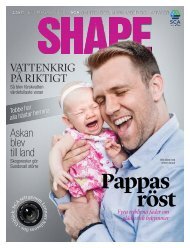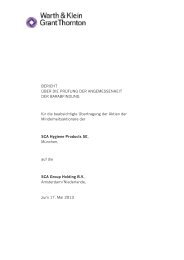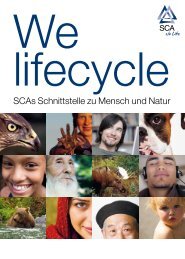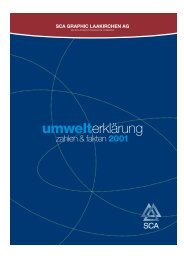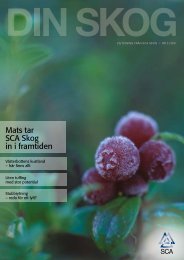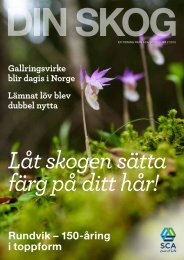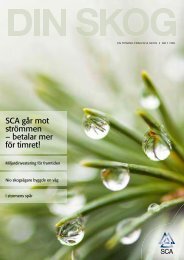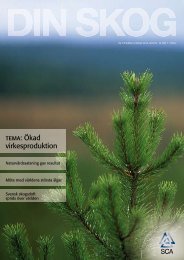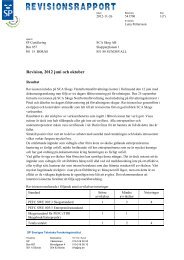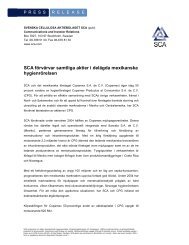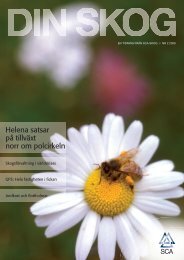SCA Graphic Paper Polska
SCA Graphic Paper Polska
SCA Graphic Paper Polska
You also want an ePaper? Increase the reach of your titles
YUMPU automatically turns print PDFs into web optimized ePapers that Google loves.
Element Value in Comments<br />
[kg CO 2 / t]<br />
Carbon Profile in Detail for <strong>SCA</strong> Ortviken 2010<br />
GraphoNews, GraphoBright, GraphoBrightExtra, GraphoCrystal, GraphoMax<br />
Based on Cepiprint and Cepifine's user guide to the carbon footprint of <strong>Graphic</strong> paper v1.0 2009.<br />
1 Carbon sequestration On <strong>SCA</strong>-owned forest land an assessment have showed some 2,6 millionne tonnes carbon dioxide sequestration,<br />
in the forest which, if allocated, give several hundreds kilogrammes of sequestrated CO2 per tonne of <strong>SCA</strong> products.<br />
The basis for calculation are only <strong>SCA</strong>-owned forests and our long history of statistics on net growth,<br />
as well as prognosis. FSC certification of forests and chain-of-custody certification of fibre supply<br />
ensures sustainable forest management.<br />
The main message are that, with <strong>SCA</strong> forest management, our forests, with todays knowledge, acts as a major<br />
carbon sink to be globally considered.<br />
2 Carbon stored in the 2 027 Amount of CO2 stored in the paper is calculated according to the IPPC formula in the user guide.<br />
product The life-cycletime of the product and destiny are important parameters if further assessed.<br />
3 CO2 emissions from 5 We have an open declaration of fuels and emissions used in our processes, third party verified and covered by CO2<br />
paper manufacturing emissions trading system.<br />
4 CO2 emissions from 5 This includes diesel oil consumption in forestry operations as harvesting and energy related emissions for<br />
fiber production seedling nurseries. Allocated after wood use.<br />
5 CO2 emissions from 0 This includes emissions generated during the manufacturing of non-wood based raw materials (Such as<br />
other raw materials pigments, main process chemicals etc.) The user guide recommends cut-off criteria of 90% i.e. to include 90% of<br />
all emissions.<br />
6 CO2 emissions from 136 The emission figure reported is calculated using country specific emission factors for grid electricity in the<br />
purchased energy country where the mill is located (IEA. (2008a). CO2 Emissions from Fuel Combustion (2008 edition)<br />
International Energy Agency.).<br />
7a) CO2 emissions from 35 This figure includes emissions from transport of raw material to the mill i.e. wood, filler, main process chemicals etc.<br />
transports Internal transports are today not included.<br />
7b) From mill to customer<br />
Euro average<br />
53 Emissions related to transport of final product to customer is included as an European average.<br />
7c) From mill to specific<br />
customer. Case study<br />
Case studys for customers can easily be performed. <strong>SCA</strong> can assist in this process.<br />
8 CO 2 emissions from Our knowledge about this are not complete today and calculations are left to be produced by our customers.<br />
product use <strong>SCA</strong> can assist in this process.<br />
9 CO 2 emissions from Our knowledge about this are not complete today and calculations are left to be produced by our customers.<br />
end of life <strong>SCA</strong> can assist in this process.<br />
10 Avoided emissions To fulfill the picture of the results of our enterprise our performed energy-related investments this toe can be<br />
included but separated from others. As <strong>SCA</strong> deliver some 3 TWh of biofuel, biopellets this can be considered as<br />
replacing fuel oil in other energy systems. Also delivered waste heat to municipal district heating can be considered<br />
replacing oil. By investing in own "green" electricity production as CHP cogeneration, water- or windpower<br />
other marginal energy sources are reduced in actual energy system. (In calculations of environmental effects a factor<br />
of 800 g CO2/kWh electricity can be used for Swedish conditions. A national electricity factor can also be more<br />
appropriate.It is then easy to downgrade the figures by multiplying data with 48/800.) Offsets are not included.<br />
All values are related to the total paper production net air dry.<br />
Figures from <strong>SCA</strong> only refers to CO2 as of now. Other GHGs, Green House Gasses, from our processes exists but are considered as of low significance with todays knowledge.<br />
Figures are based on common LCA/LCI principles. Figures are mainly third-party verified, by the means of ISO 14001, <strong>SCA</strong> RMS-verification, <strong>Paper</strong> Profile<br />
or other systems. A detailed verification of Carbon Footprints for the company are considered as important and are also initiated by <strong>SCA</strong>.<br />
Calculating all ten elements together in this Carbon Footprint does not add up to scientific standards with todays knowledge. The parts has to be communicated and<br />
used differently. However, the ten elements give the big picture of the positive effects, when using forest products (pulp, paper, included recycled paper, biofuel and<br />
sawn products)<br />
Date: 2011-02-21



